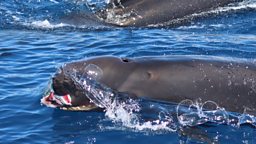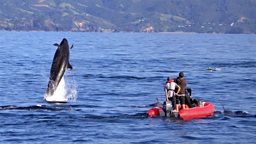Studying false killer whales and bottlenose dolphins
By Jochen Zaeschmar, founder of Far Out Ocean Research Collective

False killer whales are a fascinating species that we still have much to learn about. Like several other cetacean species, they exhibit regional cultural differences that make them very interesting to study. Our Aotearoa/New Zealand false killer whale research programme began in the year 2000 as a citizen scientist project to collect sighting information on these charismatic but largely unknown whales. Since then, we have learned a lot about New Zealand false killer whales. They live in large stable social clusters, their presence in our coastal waters is seasonal and they form long-term associations with oceanic bottlenose dolphins. The latter is a particularly intriguing part of their social organisation that is still not fully understood.
the two species spend virtually all their time together
Our long-term monitoring shows that the two species spend virtually all their time together. What’s more, the identification of individuals of both species shows that the same false killer whales return to the area year after year and that many of the dolphins that associate with the whales do so for many years.
One of our biggest challenges in the early days was just finding the whales. Their low numbers, fast travel speed and large home ranges provided some serious logistical challenges. Consequently, we were excited when the opportunity presented itself to collaborate with the Βι¶ΉΤΌΕΔ for the making of Blue Planet 2 in 2015 – the project offered the exciting possibility of an extended search effort, not only by boat but more importantly by air, and resulted in far more false killer whale encounters than we could have hoped for!
The key research findings were that false killer whales in New Zealand spend most of the summer and autumn months in coastal waters, and that all the individuals we found were part of two stable social clusters. However, while it also highlighted the close bonds between false killer whale and bottlenose dolphins it did not provide many new insights into the nature of the association.

Fast forward six years to 2021, and we were fortunate to be contacted again by the Βι¶ΉΤΌΕΔ, this time for their Mammals series. By now our sighting network had expanded significantly and we had a much better understanding of false killer whale movements in the area. We also knew that food was an important component of the false killer whale-bottlenose dolphin association, but we had little understanding of the specifics.
a mutually beneficial association that has rarely been documented in the cetacean world
This new collaboration with the Βι¶ΉΤΌΕΔ enabled us to gain fascinating insights into the foraging behaviour of both species, especially the false killer whales. The extensive underwater filming provided us with great insights into the specifics of prey capture and cooperation, both within and between species. It clearly showed that both species were actively involved in the herding of prey despite an apparent partitioning of prey species.
Bottlenose dolphins were observed targeting the smaller kahawai while false killer whales showed a clear preference for the larger kingfish. Regardless of the fish species encountered, both whales and dolphins would herd the fish cooperatively to enable their capture by the other; a mutually beneficial association that has rarely been documented in the cetacean world. The project also revealed for the first time that false killer whales often rest at night and may enter shallow bays to do so.
It was undoubtedly the attachment of camera tags to the whales that provided the most fascinating results. The key findings were that individual false killer whales actively forage at great depth even when the groups appear to be relaxing at the surface. The tag data revealed that false killer whales undertook regular dives to the sea floor and shared prey at depth and in mid water. It had previously been assumed that false killer whales foraged mainly in mid to surface waters and that food-sharing occurred mostly near the surface.

False killer whales and bottlenose dolphins hunt together off the coast of New Zealand.

False killer whales and dolphins team up
False killer whales and bottlenose dolphins hunt together off the coast of New Zealand.




























